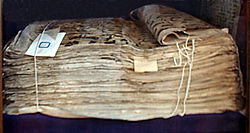
I have just returned from two weeks in Central Asia, which was highly enjoyable and a lifelong dream but, from the literary point of view relatively disappointing. I found only three bookshops, the last two on the last day. The first was, somewhat surprisingly, in the middle of Khiva. (Khiva is essentially a preserved small and very old town). It was small and mainly had textbooks. The books that it had in English were exclusively for Uzbeks wanting to learn English. However, it did have a couple of Uzbek novels translated into German, one of which I bought and plan to review shortly. I have since checked them out and they do not seem to be readily available in Europe or North America. The other two bookshops were in Turkmenistan, close to one another, on the edge of the Russian market. Both sold mainly textbooks in Russian and few books in Turkmen or Western languages. One thing we did notice was that, apart from tourists, we did not see a single person reading – books, magazine or newspapers. When I asked about this, I was told that people do not read all that much, despite (officially) a high rate of literacy, and when they do, they do so at home. In the museums, virtually the only book displayed was, not surprisingly the Koran, including the oldest Koran in the world, though there now appears to be an older one.

Turkmenistan was described by our Uzbek guide as a cross between North Korea and Dubai (or, perhaps, North Korea and Las Vegas). It single-handedly keeps the Italian marble industry in business as the president has directed that all buildings must be covered in white marble and all cars must be white. They are not there yet but are certainly making good progress. What makes it even more peculiar is that, though you do see cars, you see very few pedestrians, so it looks like a gigantic mausoleum. The previous president, Niyazov, was even more (much more, in fact) megalomaniacal than the current one (Gurbanguly Berdimuhamedov, a former dentist). A few years before his death, he built a massive mosque (it can hold around 25,000 people) as a tribute to himself, covered in gold and white marble, with a mausoleum for himself and his family next door. Both together cost several hundred million dollars. Most mosques have quotations from the Koran on them but this one has quotations from Turkmenistan’s greatest writer (in his view), i.e. Saparmurat Niyazov. In particular, the quotations come from his book, Ruhnama, which means Book of Soul. In Independence Square, there is a statue of it at least 30 feet (10 metres) high (see photo above right). And, yes, you can read it in English. I do not recommend it.
The Turkmens do recognise their other writers and there was a section in the museum devoted to a few poets. (Incidentally, the museum is very large. When we visited (with a local guide – you cannot go anywhere without a guide), we (a group of eight) were the only ones in the museum apart from the dozen or so staff members we saw.) Magtymguly is their great poet. He did not write his poetry down, coming from an oral tradition but it was so well-known that others did and it has been preserved. His poems are available in English. The statue of him (photo above) is in Independence Square along with the statues of other Turkmen poets, including Kemine, Mollanepes and Mätäji. Sadly, for me there is not much much of a novel-writing tradition in these countries.
